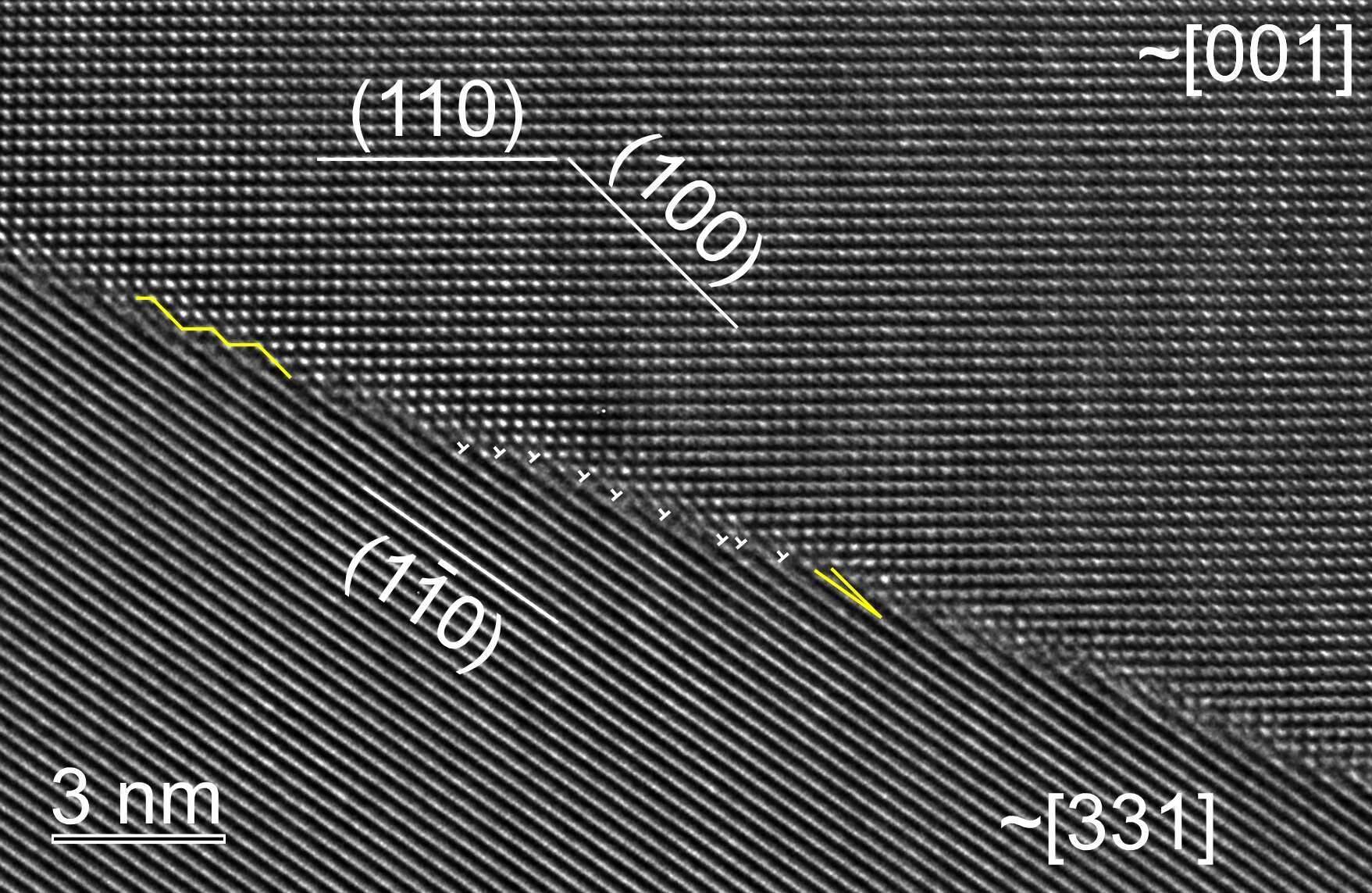The kinetics of grain boundary (GB) motion can be determined experimentally by measuring the average grain size in samples annealed at different temperatures for different durations. In SrTiO3 annealed under an oxidizing atmosphere, the GB mobility was found to decrease with an increase in temperature (in the temperature range of 1350-1425°C), deviating from the expected Arrhenius behavior [[i],[ii]]. While GB mobility can be measured, the mechanism by which a GB moves has not yet been determined at the atomistic level in general polycrystalline systems. The present work focuses on the atomistic mechanism by which GBs migrate, using high resolution transmission electron microscopy (HRTEM) and SrTiO3 as a model system.
Following the terrace ledge kink (TLK) model [[iii],[iv]], GBs were described as stepped planes which move by step-motion along the boundary plane during grain growth. The concept of steps at GBs includes line defects; such that steps can have both a step and dislocation character (so called disconnections [[v]]). The role of disconnections at GBs in GB motion is an extension to the previously described concept of surface steps which play a role in crystal growth [[vi]].
In order to examine the role of disconnections at GBs, general GBs in polycrystalline SrTiO3 and GBs between a single crystal diffusion bonded to polycrystalline SrTiO3 were characterized using aberration corrected TEM and high angle annular dark field scanning electron microscopy (HAADF STEM). TEM and STEM were used to identify steps in order to correlate them to the grain growth mechanism, following the TLK and disconnections theories.
When orienting general GBs in SrTiO3 (annealed under an oxidizing atmosphere) to the “edge-on” condition (in which the boundary plane is parallel to the electron beam direction), both steps and dislocations were visible, creating overall disconnections. The steps were found to be aligned mainly parallel to {001} and {110} type planes, regardless of the annealing temperature, annealing duration, cooling rate and orientation of the grains creating the boundary (see Figure 1) [[vii]].
The dislocation component of the disconnections can be partially characterized using a geometric approach, and was found to have an edge component mainly parallel to the same crystallographic planes. The atomistic terminations along the boundaries were found to vary.
Motion of the steps parallel to {001} and {110} type planes was recorded during in-situ HRTEM experiments along surfaces of grains in polycrystalline SrTiO3 annealed under an oxidizing atmosphere (vacuum). The steps consistently appeared along {100} and {110} planes regardless of the annealing temperature, indicating their significance in the grain growth mechanism, in agreement to the ex-situ results. The motion of such steps also appeared at the surface of shrinking grains.
Thus, the consistent appearance of certain types of steps along interfaces in SrTiO3 annealed under an oxidizing atmosphere was noted. These steps appeared in both in-situ and ex-situ experiments, indicating their role in kinetic process such as grain and crystal growth.

Figure 1: HRTEM micrograph of an edge-on general grain boundary in polycrystalline SrTiO3 annealed at 1350˚C for 10hr oxygen and furnace cooled. Nanometer length-scale steps and dislocations are visible along the boundary. The micrograph was acquired using a Cs of -5.7 μm, and Wiener filtered to remove noise.
[i] W. Rheinheimer, M.J. Hoffmann. Non-Arrhenius behavior of grain growth in strontium titanate: New evidence for a structural transition of grain boundaries, Scr. Mater. 101 (2015) 68-71.
[ii] W. Rheinheimer, M. Bäurer, C.A. Handwerker, J.E. Blendell, M.J. Hoffmann. Growth of single crystalline seeds into polycrystalline strontium titanate: Anisotropy of the mobility, intrinsic drag effects and kinetic shape of grain boundaries, Acta Mater. 95 (2015) 111-123.
[iii] H. Gleiter. Mechanism of Grain Boundary Migration, Acta Metallurgica 17 (1969) 565-573.
[iv] H. Gleiter. Theory of Grain Boundary Migration Rate, Acta Metallurgica 17 (1969) 853-862.
[v] J.P. Hirth, R.C. Pond. Steps, dislocations and disconnections as interface defects relating to structure and phase transformations, Acta Mater. 44 (1996) 4749-4763.
[vi] W.K. Burton, N. Cabrera, F.C. Frank. The Growth of Crystals and the Equilibrium Structure of their Surfaces, Philosophical Transactions of the Royal Society of London A: Mathematical, Physical and Engineering Sciences 243 (1951) 299-358.
[vii] H. Sternlicht, W. Rheinheimer, M. Hoffmann, W. Kaplan. The mechanism of grain boundary motion in SrTiO3, J. Mater. Sci. 51 (2016) 467-475.

